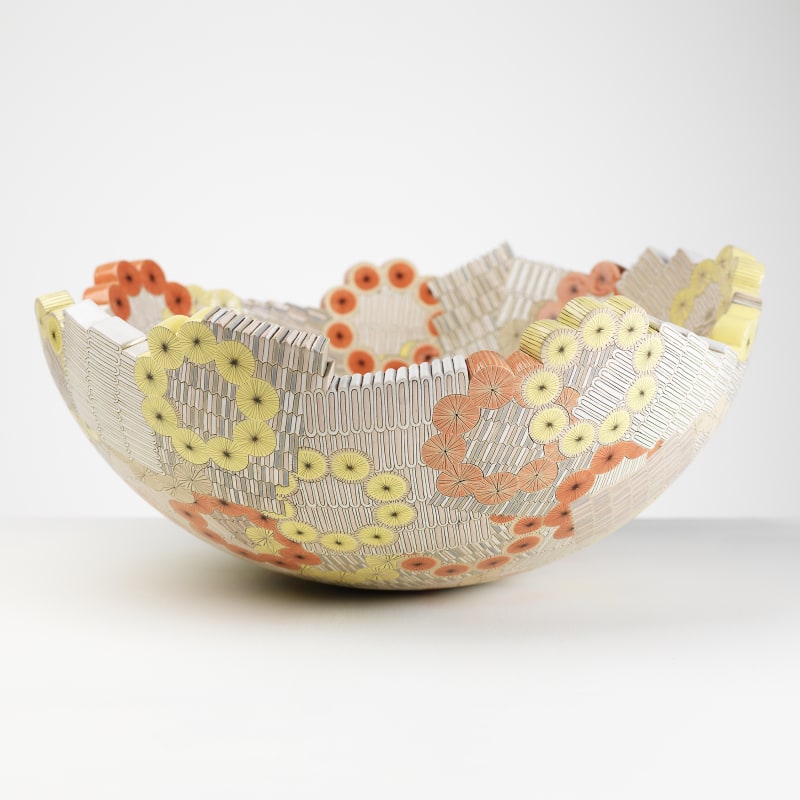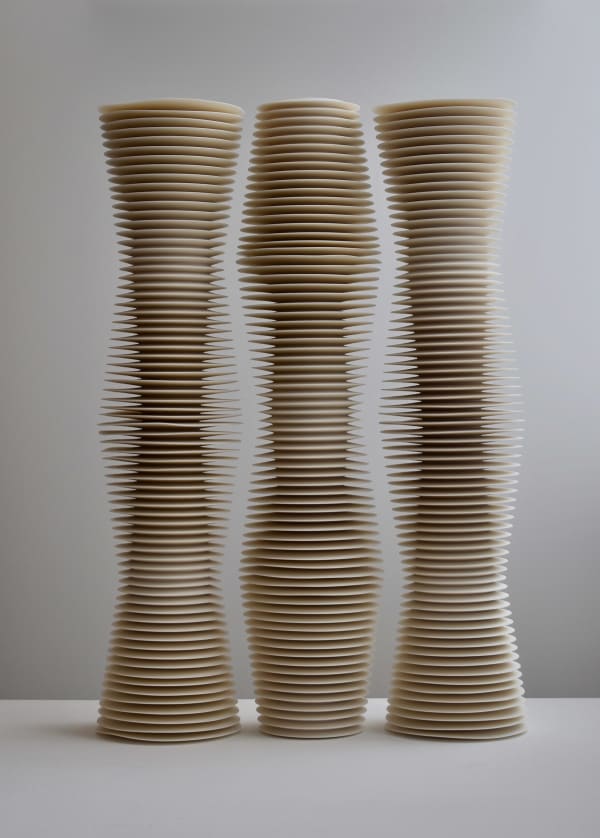Alter
“Alter”, a ceramic exhibition which examines the transformative qualities of clay and the belief in the transformative power of material thinking through innovation and experimentation.
Featuring the work of ceramic artists; Matthew Chambers, Ashraf Hanna, Akiko Hirai, Leah Jensen, Nicholas Lees, Frances Priest, Hannah Tounsend and Annie Turner.
Fitzrovia Chapel, 2 Pearson Square, Fitzrovia, London W1T 3BF
Open to the public daily from Wednesday, November 27th, 2019 – Sunday, December 1st, 2019 – 11am – 4pm
“Alter” is an exhibition of the work of eight UK based ceramic artists who, as vanguards of their field, are forging the way forward for a more defined cultural positioning of ceramic art. Using a combination of exceptionally honed technical skills, innate understanding of the material and boundless creativity, each artist produces work which glances back at the history of ceramics and forwards to the limitless possibilities of its future.
The ceramic exhibition will be set in the beautifully ornate, Fitzrovia Chapel, once the chapel for patients, staff, and visitors of the former Middlesex Hospital, a building steeped in history, nestled in a quiet corner of Pearson Square amongst new buildings. In the same way old and new architecture merges on the outside, inside, these chosen artists merge their skills, both contemporary in aesthetic yet old school in their traditional approach. Each artist has evolved time-honoured processes to new and wondrous shapeshifting results.
New to the Cavaliero Finn portfolio, we are delighted to be working with Leah Jensen for this ceramic exhibition. It was the healing role of the chapel that inspired Leah Jensen’s latest creation and her work for “Alter”. Working from the early Renaissance painting by Fra Angelico, The Healing of Justinian by Saint Cosmas and Saint Damian (shown above) which features two saints of healing, Leah examines and deconstructs the painting to its fundamental elements. This is a technique that the artist developed after learning about the maths and planning some of the great masters used when considering their composition. In doing so, she unearths hidden geometric structures that reside beneath the surface of the painting. Leah maps out these patterns and forms and translates these by applying images of the painting using pins and paper on to a hand-built, unfired clay vessel, using the clay as a canvas. She then carves out these precise yet abstract patterns, creating a unique, meticulously planned contemporary object very much influenced by the past. Once the vessel is complete the narrative is hidden, just as in the geometric structure of the painting before it.
You can find out more about Leah’s work by reading our interview with the artist or by booking a free ticket to the special talk she is giving visitors to Alter at Fitzrovia Chapel on Saturday 30th November from 2-3pm.
One of this year’s Loewe Craft Prize finalists, artist Annie Turner’s ceramic sculptures can be seen as an external testimony to her connection with the River Deben and its surrounding marshlands where her family has lived for several generations. Her work is literally imbued with the debris from the River Deben bed, giving the appearance it has been around for centuries, aged and eroded over time. Through control of the kiln temperature, the work is altered and Annie can influence the bend and collapse that have become so recognisable in her delicate ceramic sculptural forms.
Award-winning artist, Hannah Tounsend, creates sculptural vessels using a unique hybrid making technique of slip-casting and throwing. Within an open plaster mould Hannah builds layers of printed, poured and painted casting slips, overlaying colours on the porous surface. Using a throwing wheel, the top section is added to the still-moulded cast and fully thrown out. The presence of the mould allows the formation of a flange of clay that accentuates the join and breaks away in pleasingly irregular fragments as the piece shrinks and pulls inwards. Hannah is one of this year’s 10 finalists for the prestigious British Ceramics Biennial prize ‘AWARD’, a prize that celebrates innovative ceramic artists. The winner will be announced in the Autumn 2019.
The pinch pot is a simple form of hand-made pottery produced from ancient times to the present. This traditional pinching method is the starting point for Ashraf Hanna’s sculptural vessels. In this ceramic exhibition, Ashraf will present a large installation of cut and altered vessels which are concerned with exploring line volume and space. Ashraf incorporates strong lines and curves in his sculptural forms built using a combination of pinch pot and slab building techniques.
Ashraf has recently added the Fitzwilliam Museum, Cambridge and The Art Centre at Aberystwyth University to his increasingly long list of public institutions that have acquired his work.
Frances Priest creates intricate and colourful objects that celebrate her fascination with ornament and pattern. Like Leah Jensen she references art history in her work finding inspiration from a long line of cultural patterns, producing a body of work reflecting on and reinterpreting chapters from the pattern book, ‘The Grammar of Ornament’ by Victorian architect and designer Owen Jones as well as drawing on patterns discovered during her own travels around the globe.
Frances uses hand building and press moulding techniques to make her sculptural forms, refining them back to very smooth, pristine surfaces. The patterns are then inscribed into the clay using a combination of scalpel and hand-formed aluminium stamps, along with paper stencils and graph paper used for plotting out designs. She usually works on paper first to develop the pattern designs before moving onto clay test tiles to work out how to translate these designs into clay. Later these tiles become useful for glaze testing. She likes the patterns to have a life of their own so there is an element of chance in how the final designs are drawn out, almost like a controlled doodle.
Depending on the scale of the work, the drawing can take up to a month to complete. The work is then left to dry slowly and evenly before a high bisque firing. Once fired, she uses oxide washes to highlight the inscribed lines and a combination of hand-painted glaze and vitreous slips to add the surface colour. The combination of gloss glaze and matt slip adds another level of interest to the finished surfaces and she also likes to incorporate the clay body into the finished designs.
Also, like ceramic artist Leah Jensen, she sees the works as drawings in clay and she treats the surface much like a sheet of paper, with the scalpel as a pen and the glaze and slips like gouache paint. The entirety of the piece is enveloped in the surface design so the works appear to be wrapped in or constructed out of the pattern.
Frances’ work was recently purchased by The Fitzwilliam Museum in Cambridge and The National Museum of Scotland.
Another finalist of this year’s Loewe Craft Prize showing at this ceramic exhibition is Akiko Hirai, who is interested in the planned outcome of imperfection. The biggest things come from random altering acts inside the wood-fired kiln. Through a combination of hand building, coiling, using the wheel, as well as several glazing techniques, the process of experimentation is key to her philosophy of working with nature and the idea of “beauty in imperfection”.
Matthew Chambers studied ceramics at Bath Spa University under the tutelage of fellow exhibitor and lecturer, Nicholas Lees, and completed his MA at the RCA. Here he combined newly learnt techniques with the accomplished traditional throwing techniques honed from years working in studio pottery with Philip Wood in Nunney, Somerset. These merged skills create incredibly intricate sculptures that appear to have infinite depth. His circular concentric sculptures never fail to astound and amaze viewers all intrigued to learn his process which he keeps firmly to himself, preferring to maintain the element of mystery in his work. This year Matthew Chambers’ work was acquired by the Victoria and Albert Museum to add to their permanent contemporary ceramic collection.
Nicholas Lees primarily uses Parian – a porcelanous clay body first developed in the 19th century to imitate creamy white Greek marble. He doesn’t glaze his work as Parian porcelain his a vitrified surface finish. The pieces originate on the wheel, where they are made as deliberately thick-walled vessels with tapering width to the walls. He dries the pieces slowly, continually wrapping and unwrapping them over a period of weeks, in order to achieve an even dryish leather-hard state which must be consistent through the thickness of the clay. When ready, a piece is mounted on the lathe and fitted onto a specially turned plaster chuck. The turning is largely done by eye using specially made tools – it can take up to 6 hours for an individual piece. The pieces are then fired once. After firing Nicholas then uses a diamond abrasive to grind angles and bases on to the pieces. Some pieces are assembled from multiple parts ground to fit precisely and glued together.
Fitzrovia Chapel was designed by the Gothic Revivalist architect, John Loughborough Pearson and after his death in 1897 was completed by his son Frank Pearson in 1929.
From outside, the chapel is simple red brickwork, with no hint of the beauty that lies inside. Once through the door, however, the chapel literally glows. Practically, every inch of the inside is decorated with coloured marbles or mosaics: azure domed arcs and arches, typical of Pearson’s ecclesiastic architectural designs, echo the sky outside. Inspired by San Marco in Venice, Frank Pearson employed Italian craftsmen and imported the finest materials including seventeen different kinds of marble.
We look forward to seeing you at the exhibition.
-

Akiko Hirai, Moon Jar, stoneware, porcelain, wood ash, white feldspatic glaze, 2018
-

Three Poppy Seed Pods by Akiko Hirai
-

Poppy Pods by Akiko Hirai
-

Triptych by Nicholas Lees
-

‘Triptych’ (19.35)
H62 x W45 x D15 cms, Porcelain, 2019 -

Triptych detail by Nicholas Lees
-

Statement Print Vessels by Hannah Tounsend, 2019
-

Fitzrovia Chapel's altar plays host to works by Ashraf Hanna
-

At the Altar,,,,
Net by Annie Turner
Installation of Cut and Altered Vessels by Ashraf Hanna
The Healing of Justinian by Leah Jensen
-

Matthew Chambers, Pink Fade, stoneware 2019
-

Annie Turner - Net, red grogged clay, lithium glaze, yellow iron oxide, 2019
-

Ashraf Hanna, series of cut and altered vessels, ceramic, 2019
-

Ashraf Hanna, series of cut and altered vessels, ceramic, 2019
-

Healing of Justinian by Leah Jensen
-

Work in progress – The developing pattern on Leah Jensen’s latest work for Alter at Fitzrovia Chapel is meticulously planned.
-

The starting point of Leah Jensen’s latest work for Alter,
The Healing of Justinian by Saint Cosmas and Saint Damian, by Fra Angelico, 1438-40,Tempera on wood, 37 x 45 cm, Museo di San Marco, Florence
-

Orange Twist by Matthew Chambers 2019
-

-

Sculptures by Matthew Chambers
-

Frances Priest, Gathering Places – Collage #3, Incised ceramic with oxide wash, vitreous slip & glaze, 19 x 41.9 cm.
-

Grammar of Ornament India collection by Frances Priest
-

Blue Floating Bowl by Nicholas Lees, one of three purchased by Sir Nicholas and Judith Goodison at the show for the Fitzwilliam Museum in Cambridge
-

Blue Floating Bowls by Nicholas Lees, purchased by Sir Nicholas and Judith Goodison at the show for the Fitzwilliam Museum in Cambridge

































